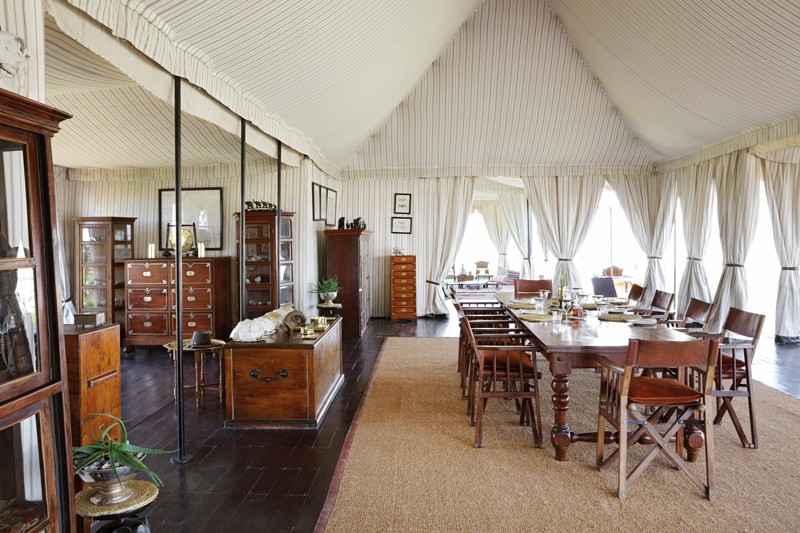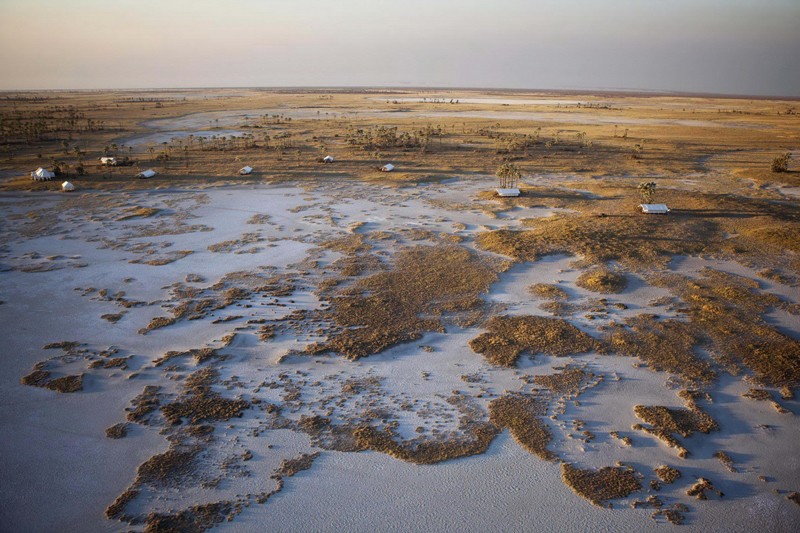San Camp
San Camp is a beautiful boutique camp located on the very edge of Ntwetwe Pan, bordering the Makgadikgadi Pans National Park.
San Camp is one of the most individual, escapist and tranquil camps in Africa. This is due mainly to its stunning location on the edge of Ntwetwe Pan – few camps can ever offer the feeling of space and solitude that the San Camp evokes. The camp is small and upmarket, with excellent service, good food and a warm welcome, and the varied activities are excellently guided. The only negative is the price, which will put off many travellers, but if this isn’t an issue then San Camp can cater for outdoor enthusiasts and luxury travellers alike. Compared to its better known sister camp, Jack’s Camp, San Camp is smaller and has a more stunning, out there location next to the pans.
The Makgadikgadi Pans are well worth a visit for anyone who enjoys exploring different habitats and landscapes, and is prepared to compromise a little on the big game experience in favour of geographical diversity and more specialist wildlife viewing. The specialist wildlife is worth a particular mention as it is sometimes the key reason for visiting the area – brown hyaena, aardvark, aardwolf and habituated meerkats.
Rooms
San Camp caters for up to 14 guests in six luxurious white canvas ‘old-style’ safari tents, each containing four-poster iron beds (5 doubles and 2 twins), bedside tables and luggage racks. To the front of each tent is a small verandah with views out across the pan, whilst at the rear is an en-suite plumbed bathroom. The tents have all been cleverly positioned beneath towering Molokwane palms that provide welcome shade during the heat of the day.
Central Areas
There is a central dining and lounge tent, stylishly furnished and offering views out across the edge of the pan, as well as a small swimming pool.
Facilities
Wi-Fi – Yes
Power for charging – Yes
Swimming pool – Yes
Habitat & Wildlife
The Makgadikgadi Pans are not a mainstream safari destination. Together with the adjacent Nxai Pan, the Makgadikgadi Pans cover an area of nearly 5500 sq. miles. The pans, remnants of a huge inland sea, are largely void of vegetation except for a few areas of open grassland and isolated baobab islands. During the rains, from December to March, the pans fill up and attract large numbers of water birds including flamingos and pelicans. Great herds of wildebeest, gemsbok, springbok and zebra also gather, as do predators such as lion and cheetah who move in during this time of plenty. This is also the time that the zebra migration traverses the plains of the concession and is the second largest migration in African. Even the occasional elephant is seen passing through! However, once the dry season sets in, the water reliant species migrate to leave an empty wilderness with an eerie silence and only specialist species remain in the grassland and scrub bush that fringe the pans. Brown hyaena and meerkats are two of the key species of interest found within the Kalahari ecosystem, whilst others include ostrich, aardvark, aardwolf, spring hare, black-backed jackal, African wild cat and porcupine.
The recent introduction of pumped water holes on the local concession is supporting the resident wildlife and encouraging more game to remain in the area during the long dry season. In particular, elephants are being seen more regularly. However, it is a delicate balance and it will take a few years to discover what the carrying capacity of the area is during the dry season.
Activities
As San Camp only opens during the dry season activities include game drives (by day and night), bushman walks and exploring the pans by quad bike which is a key experience and often undertaken in the afternoon ending with sundowner drinks overlooking the pans. The guided walks are usually hosted by Bushman trackers who can show you how they survive in this harsh landscape, whilst night game drives are very productive and good for specialist species such as brown hyaena and aardvark) and the exploration of undocumented archaeological sites. A further highlight available throughout the year is a dawn visit to a local habituated meerkat colony where you can sit quietly and watch the meerkats at close range. Beware, they may use you as a lookout point!
Horse-back safaris are also available as a local activity, or for more experienced riders it is possible to arrange multi-day riding safaris across the pans.
For anyone really keen to explore the salt pans in depth by quad bike, camping excursions to a rocky outcrop in the middle of the pans known as Kubu Island may be arranged (this should be booked in advance and is only available during the dry season).
The most recent addition to the portfolio is a small helicopter which is available for hire to undertake scenic flights over the pans, the surrounding grasslands and to Kubu Island.
Seasons
San Camp is open during the dry season only from mid-April to mid-October.
San Camp does accept children of all ages, though with limited central areas, no family tents and relatively cosy standard tents it is arguably not the best option with younger children. However, for families with older children who can sleep in their own tent it can be a fantastic family option. The variety of activities and quality of hosting and guiding make it a very upmarket and interesting family adventure. The swimming pool is a welcome attraction during the heat of the day, but the water is a bit cold! Families with children under 12 years of age need to book a private vehicle.
San Camp supports the Makgadikgadi Conservation Initiative which promotes the expansion of large mammal migration routes between northern Botswana (Chobe and the Okavango) and the Kalahari Desert (specifically the Makgadikgadi National Park) which have been cut short by the implementation of mass fencing. The aim is to stop the restriction of this movement by working alongside local communities to develop land use that benefits everyone and yet allows the migrating animals, mostly zebra and wildebeest but also elephants and other plains game, to move freely.
Another initiative they support is leopard population dynamics and conservation in the Khwai area of Botswana (eastern Okavango) through the Botswana Predator Conservation Trust. The Trust aims to establish territory locations, sizes and threats to leopards which reside inside the private reserve compared to those whose territories are closer to villages. This information enables them to learn about the survival strategies and intra-species interactions of leopards so they can therefore focus on the areas in need of human-predator conflict alleviation.
Coaching for Conservation’s programme Connecting Conservation Classrooms is all about educating Botswana’s children on the value of wildlife and respect of their environment and uses Natural Selection lodges (of which San Camp Kalahari) as visitor classrooms.
Together with their sister camps, Jack’s Camp and Camp Kalahari, San Camp also work with and provide employment for local bushman families, helping them to maintain their traditions and pass on skills to their children.















